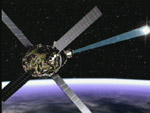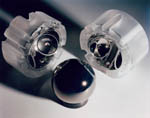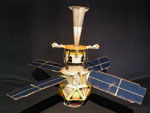WEEKLY HIGHLIGHTS FOR 2 JULY 2004:
GRAVITY PROBE B MISSION UPDATE

At a little over ten weeks into the mission, the spacecraft is in excellent health, with all subsystems performing well. The spacecraft’s orbit remains stable, ready for the transition into the Science Phase. All four gyros are digitally suspended and have completed calibration testing at approximately 0.3 Hz (18 rpm) spin rates. Two problematic micro thrusters, which were preventing the spacecraft from sustaining a drag-free orbit, have been isolated, and the thruster-control software was modified to optimize Attitude and Translation Control system (ATC) functionality without them. Over the past two weeks, the spacecraft’s roll rate was increased from 0.3 rpm to 0.9 rpm as part of the process of uniformly distributing and balancing the mass of the spacecraft..
- During this past week, we completed the mass trim procedure at 0.9 rpm,
using movable weights on long screw shafts to alter the spacecraft’s
center of mass from front to back and from side to side. The mass trim operation
is necessary to precisely align the spacecraft’s roll axis so that
it passes through the centers of the gyros and the telescope’s line
of sight. The mass trim procedure also balances the mass of the spacecraft
so that it rolls smoothly around this axis.
- Also, this past week, we decreased the spacecraft’s roll rate incrementally from 0.9 rpm back to 0.5 rpm. During the first roll-down decrement to 0.7 rpm, we discovered that the distribution of the liquid helium in the Dewar is less predictable during roll-down than it is during roll-up. When the spacecraft’s roll rate is slowed too quickly, the liquid helium begins to slosh around. The resulting displacement of the center of mass from the sloshing helium affects the micro thrusters, resulting in a significant increase in the time required to complete the roll-down.

- Last weekend, in preparation for optimizing ATC performance with 14 instead
of 16 micro thrusters, we uploaded revised drag-free thruster-control software
to the on-board computer. After completing the mass trim maneuver and stabilizing
the spacecraft at the 0.5 rpm roll rate, we re-booted the on-board computer
with the revised software. The re-boot went very smoothly, and a checkout
of the new software confirms that the two problematic thrusters are isolated
and receiving no helium, while the remaining 14 thrusters are responding
to commands as expected. With the new software up and running, we have begun
successfully testing both primary and backup drag-free modes around gyro
#1.
- Meanwhile, gyro #1 and gyro #3 are currently in the process of being spun up to 3 Hz (180 rpm), and likewise, gyros #2 and #4 will be spun up to 3 Hz next week. Over this weekend, the team will also re-lock the science telescope on the guide star, IM Pegasi, with the spacecraft rolling at 0.5 rpm and balanced along the telescope’s axis of sight. Before we begin calibration testing of the gyros at a spin rate of 3 Hz next week, our goal is to have the spacecraft rolling smoothly at 0.5 rpm, locked onto the guide star, and in a drag-free orbit around one of the gyros.

- This week, we are pleased to announce two welcome additions to our GP-B
Web site. First, we have added a Visual Tour of our spacecraft and payload.
You can access this tour by using the navigation menu along the left edge
of our Web pages. Choose the second item, The
Engineering Story, and from
that sub-menu, choose Visual
Tour.
- The second addition to our Web site is a 1/20 scale, paper model of the GP-B spacecraft that you can download as a PDF file, print out, and assemble. There are two versions of the PDF file—a 12 MB high-quality version and a 2 MB low-quality version. The only visible difference between the versions is that the colors are not as bright and saturated in the low-quality version, but it will download in much less time for people with low-speed Internet connections.
Both versions include two pages of instructions and six pages of images to cut out and assemble. You’ll need scissors, an Exacto knife, a straight edge, glue (glue sticks and hot glue guns work well), Scotch tape, two 9.5” long, 1/8” diameter wooden dowels (shish-kabob skewers work well) about 3-5 hours, and patience to assemble the model. For best results, print the cut-out pages of the model on heavyweight paper. Glossy photo paper is a bit hard to work with, but it yields a very realistic-looking model.
Kate Stephenson, a Stanford graduate in Mechanical Engineering, created both the spacecraft visual tour and the paper model. Over the past few years, Kate has worked on a number of graphic design projects at GP-B, including our Web site.
The spacecraft is being controlled from the Gravity Probe B Mission Operations Center, located here at Stanford University. The Stanford-NASA/MSFC-Lockheed Martin operations team is continuing to perform superbly.
Please Note: During the Initialization & Orbit Checkout (IOC) Phase of the GP-B mission, we update this Web site and send out an email update once a week (usually on Thursday or Friday) to keep you apprised of our progress. From time to time, we may post and email extra updates, as warranted by mission events.
Photos & Images: The drawing of the GP-B spacecraft in orbit, was extracted from an animation created by Adam Jeziak and Aaron Pozzer. This animation is part of a 26-minute movie about GP-B, entitled Testing Einstein's Universe (see description below). The first photo, taken in the W.W. Hansen Experimental Physics Lab at Stanford University in 1999, shows one of the mass trim mechanisms before it was mounted on the spacecraft. The second photo, showing the GP-B gyroscope rotor (sphere) and housings, was taken by photographer Don Harlan. Finally, the photo of the paper model of the GP-B spacecraft was taken by GP-B Public Affairs Coordinator Bob Kahn. Click on the thumbnails to view enlarged copies of these images.
LEARN MORE ABOUT THE GP-B GUIDE STAR, IM PEGASI
For an overview about why we chose IM Pegasi as our guide star, and its importance to the GP-B mission, see our Guide Star FAQ. Also, pages 18-20 of the Gravity Probe B Launch Companion contain information about the guide star and the science telescope.
Furthermore, the ETH Institute of Astronomy in Zurich, Switzerland, is working with the Harvard-Smithsonian Center for Astrophysics to provide detailed optical information about the GP-B guide star, IM Pegasi. You can find out about the ETH Institute's work in monitoring magnetic activity on IM Pegasi and the Doppler Imaging Technique used for this purpose on the ETH Institute of Astronomy GP-B Web page.
Last but certainly not least is the fine web site created by York University that describes the official research done for Gravity Probe B.
Some readers have asked for alternative names for IM Pegasi as might be found in different stellar catalogs and charts. Those include: IM Peg, HR 8703, HD 216489, SAO 108231, BD +16 4831, FK5: 3829
TRACKING THE GP-B SPACECRAFT
Find the Gravity Probe B satellite in the sky at NASA's satellite tracking web site. See where GP-B is with respect to the terminator (the day-night boundary on the Earth's surface), or just enter your zip code to see if GP-B might be over your neighborhood. The best time to look for it is usually at dusk.
Also, you can track the GP-B spacecraft on your Palm OS or Pocket PC Personal Digital Assistant (PDA), using either PocketSat or PocketSat+ from Big Fat Tail Productions. Both products are PDA Shareware, so you can try them out for free. If you decide to use them, Big Fat Tail asks that you pay a nominal shareware fee.
FOLLOW IOC ACTIVITIES AND LEARN MORE ABOUT GRAVITY PROBE B
If you are interested in following the IOC procedures more closely, you'll find a schedule and description of them on pages 12-14 of the Gravity Probe B Launch Companion. This document also provides an overview and explanation of the Gravity Probe B experiment and information about the spacecraft and GP-B's amazing technologies. Click here to download the GP-B Launch Companion in Adobe Acrobat PDF format. (Please note: this file is 1.6 MB, so it may take awhile to download if you have a slow Internet connection.)
Norbert Bartel, Professor of Astrophysics and Space Sciences at York University in Toronto, Canada, has produced and directed a 26-minute documentary movie about the Gravity Probe B experiment entitled, Testing Einstein's Universe. This movie, along with 80 minutes of additional video about relativity, physics, and astronomy is available on a DVD, which you can purchase from the Website: http://www.astronomyfilms.com/
VIEW A VIDEO OF THE GP-B LAUNCH
 Click
here to view a 3 1/2 minute QuickTime video clip of the GP-B launch, produced
by the Stanford News Service. Please note that the video requires Quick Time to play.
Click here to
link to
download Quick Time.
Click
here to view a 3 1/2 minute QuickTime video clip of the GP-B launch, produced
by the Stanford News Service. Please note that the video requires Quick Time to play.
Click here to
link to
download Quick Time.![]()
FOLLOWING THE GP-B MISSION ON THE WEB
In addition to this Web site, here are some other Web sites that have information, photos, and video of the GP-B launch and mission.
- The ELV Missions Virtual Launch Center Web page on the John F. Kennedy Space Center Web site has information and several streaming video clips covering the GP-B mission. (You can view these video clips free of charge, but you will need to have either the Real Media Player or Windows Media Player installed on your computer to view them.)
- NASA's Marshall Space Flight Center Gravity Probe B.com Web page has a number of great photos from the GP-B launch, including photos of the spacecraft separation, as well as other information about Gravity Probe B.
- The Science @ NASA Web site, hosted by NASA's Marshall Space Flight Center, posts several stories each month about scientific research projects in which NASA is involved. This site currently features two general interest stories about Gravity Probe B: In search of Gravitomagnetism and A Pocket of Near Perfection. (In addition to the Web versions, these stories are also available in both plain text and streaming audio formats.)
- Photographer William G. Hartenstein's Web site has an extraordinary set of photos that he took on launch day.
- Another very comprehensive source of information about the GP-B launch is the Spaceflight Now Web site. This site contains an excellent photo gallery, as well as a number of Quicktime video clips of the launch. However, you have to become a subscriber to this site ($$$) in order to view the video clips.
GRAVITY PROBE B IN THE NEWS
Sunday evening, April 18th, a feature story about Gravity Probe B and principal investigator, Francis Everitt, aired on ABC World News Tonight. Click here to read a text version of the ABC News story. Also on April 18th, NPR's David Kestenbaum talked with GP-B's principal investigator, Francis Everitt on the program All Things Considered. On Friday, April 16th, Gravity Probe B Co-Principal Investigator, John Turneaure, was interviewed by Ira Flatow on NPR Talk of the Nation—Science Friday.
On Tuesday, April 13,2004, Gravity Probe B was the lead story in the Science section of the New York Times, and it was one of the front page stories in the San Jose Mercury News. (You'll need to register on the Web sites of these newspapers to view these stories online.) In addition, a story about GP-B appeared on the New Scientist Web on April 13, 2004.
The official pre-launch Gravity Probe B mission and science briefing was held on Friday, April 2, 2004 at 1:00 PM Eastern Daylight Time at NASA Headquarters in Washington, D.C. The participants in the briefing (pictured from left to right in the photo) were:

- Anne Kinney, Director of Astronomy/Physics Division, NASA Headquarters
- Rex Geveden, Program Manager, GP-B and Deputy Director, NASA's Marshall Space Flight Center in Huntsville, Alabama.
- Francis Everitt, GP-B Principal Investigator at Stanford University, Stanford, California
- Bradford Parkinson, GP-B Co-Principal Investigator at Stanford University, Stanford California
- Kip Thorne, Feynman Professor of Theoretical Physics, California Institute of Technology, Pasadena, California
You can view a Real Player streaming video of this briefing on the Kennedy Space Center GP-B Web site.
RECEIVE GRAVITY PROBE B WEEKLY HIGHLIGHTS BY EMAIL
If you are interested in automatically receiving these weekly highlights and other important GP-B mission information by email, you can subscribe to our Gravity Probe B Update email list by sending an email message to "majordomo@lists.Stanford.edu" with the command "subscribe gpb-update" in the body of the message (not in the Subject line). You can unsubscribe from this mailing list at any time by sending an email message to the same address with the command, "unsubscribe gpb-update" in the body of the message.
Previous Highlight
Index of Highlights

